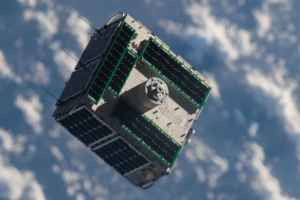The AggieSat4 (AGS4) satellite carrying Bevo-2 was unpacked and assembled aboard the International Space Station (ISS) on Wednesday (Jan. 27), and was released into outer space on Friday (Jan. 29). AggieSat4 launched from Cape Canaveral Air Force Station in Florida for the ISS on December 2015.

AGS4 drifting away from the ISS.
This successful deploy marks AggieSat Lab’s fourth successful mission and the most ambitious yet.

AGS4 moments after deployment from the CYCLOPS manipulator
Several days after the release of AGS4, and upon verification that all systems are running correctly, the satellite powered on its torque coils and detumbled itself. The torque coils generate a strong magnetic field that will orient AGS4 along the magnetic field of the Earth. There are three torque coils on board giving full 3-Axis motion. The detumble process will negate any rotation imparted on AGS4 by the CYCLOPS deployment mechanism and orient AGS4 for optimal data downlinking. Once this is done data from the satellite can be downloaded faster and all necessary software patches can be uplinked to AGS4.
Thirty-one days after the deployment of AggieSat4 a timer will end preventing the Bevo-2 operations phase from initiating. Once this timer has ended and the team has concurrence with the NASA Payload Operations and Integration Console (POIC), AGS4 will deploy the Texas Spacecraft Laboratory Bevo-2 satellite. As soon as the deployment occurs, AggieSat4 will begin capturing images of the separation of the two spacecraft. The two satellites will then begin sending each other their relative positions in space. After several hours, the spacecraft will be too far apart to continue operations and this phase of the mission will end. This is ultimately the entire point of sending LONESTAR-2 into orbit; it is a test of the systems that would go on a future fully Autonomous Rendezvous and Docking (ARD) mission, which is the goal of the LONESTAR campaign.
A video of the deployment can be found here.
For more information, please visit the AggieSat Lab website.
For the latest updates on the AggieSat4 mission, please visit their Facebook page.




